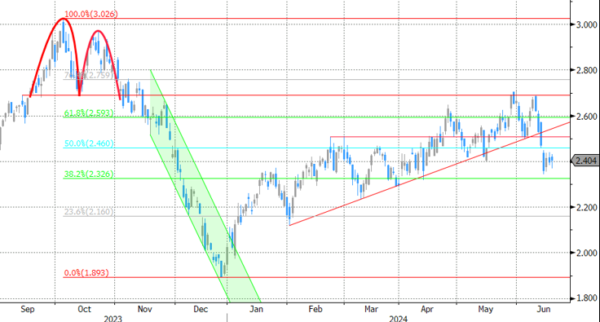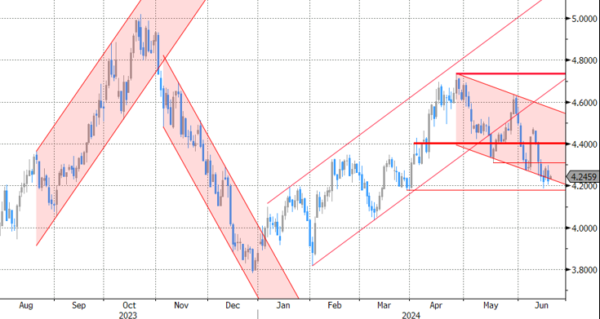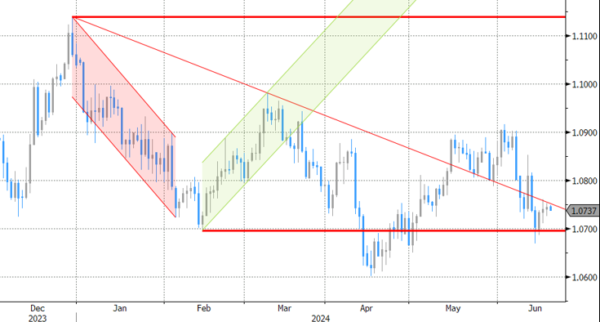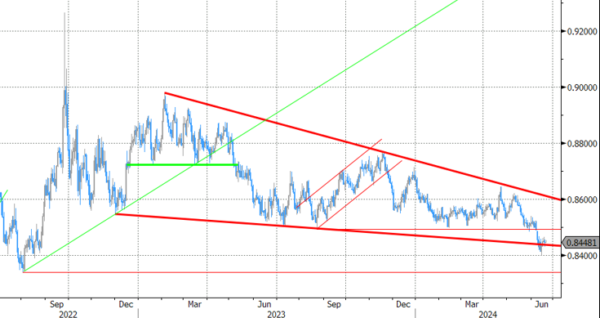Markets
EMU and UK markets yesterday had to develop their own dynamics with no guidance from the US (markets closed for the Juneteenth holiday). The European Commission activated the ‘excessive deficit procedure’ for 7 member states to rectify persistent budgetary slippage. In a separate study on its website, the ECB also published an in extenso article on the huge fiscal pressures EU/EMU countries are facing to cope with the challenges of an ageing population, higher defense spending and climate change and closing the digitalization gap, which are coming on top of current debt burden (cf infra). In calm session, (10-y) intra-EMU spreads (vs Germany) still widened a few bps for peripheral markets (Italy +3 bps, Spain & Portugal +1 bp). France also widened 2 bps. German yields gained less than 1 bp across the curve. The euro showed no clear directional trend with EUR/USD closing marginally higher at 1.0745. UK Gilts underperformed Bunds rising between 4.1 bps (2-y) and 1.7 bps (5-y). UK headline CPI in May returned to BoE‘s 2.0% target but core (0.5% M/M and 3.5% Y/Y) and services inflation (+0.6% M/M and 5.7% Y/Y) indicated that it’s much too early for the BoE already to declare victory. Sterling temporarily gained post the release, but gains could not be sustained. EUR/GBP close the session little changed at 0.8447.
Asian equity markets this morning mostly show modest losses with China tentatively underperforming (CSI 300 -0.55%). The PBOC set the yuan’s fixing at the weakest levels since November, suggesting an further cautious stimulative approach. The on-shore yuan weakens to USD/CNY 7.26. At the restart in Asia, US yields add 2-3 bps across the curve. The dollar also gains a few ticks (EUR/USD 1.0740, DXY 105.3, USD/JPY 158.15).
Later today, the US calendar contains jobless claims, housing starts and permits and the Philly Fed business outlook. After a recent jump higher, especially jobless claims might have some intraday impact. The Swiss National Bank, the Norges Bank and the Bank of England will decide on monetary policy. Markets are divided whether the SNB should follow-up on the March 25 bps cut. The Norges Bank and the BoE probably have no room yet to give concrete guidance on the start of an easing cycle. EUR/GBP for now found a new ST equilibrium between 0.84 and 0.85.
News & Views
New Zealand’s economy escaped from a recession in Q1 of this year. GDP expanded at a modest 0.2% q/q, bringing the yearly figure to 0.3%. The numbers were slightly better than expected though in line with the central bank’s (RBNZ) forecast. Household consumption picked up from 0.6% to 1.6% q/q while government expenditures declined by -0.3%. Rising inventories supported growth while capital investments were a strong drag (-1.3%). Net exports also weighed heavily on the 2024Q1 figure due to a sharp increase in imports (+6.1%). The growth numbers don’t bring a lot of cheer but they won’t entice the RBNZ to cut rates anytime soon. Its chief economist Conway on Tuesday repeated the need to keep the policy rate restrictive for a long enough period, citing still-widespread inflation pressures. Additionally, underlying gauges including services/non-tradeable CPI prove sticky while the economy is expected to gradually gain traction in coming quarters. The central bank last month flagged no cuts before 2025H2. Money markets bet on a first move in November this year. New Zealand swap yields jumped between 5.3 and 7.3 bps after the release but the kiwi dollar barely budged. NZD/USD hovers near 0.613.
The ECB in a publication yesterday outlined and calculated the brutal reality of the fiscal challenges the European bloc is facing in the decades ahead. It calculated that for the euro area to reduce government debt levels towards the 60% level by 2070, an immediate and permanent effort of 2% of GDP is needed annually. This comprises a 1.4% adjustment just to maintain debt levels at the 2023 levels, complemented by a 0.6% effort in order to actually reduce debt levels. Additional costs complicate the picture. The central bank singled out three trends that await member states: demographic ageing (leading to increased costs in pensions, health & long-term care and education), filling the defence gap and climate change. These are estimated to increase the efforts needed by another 3% in coming decades (1.2%, 0,5% and 1.1% respectively). For some individual countries, the situation is much worse. Belgium’s fiscal challenge is guesstimated at more than 7%. Slovakia tops the board with a more than 9% effort needed.
Graphs
GE 10y yield
The ECB cut its key policy rates by 25 bps at the June policy meeting. A more bumpy inflation path in H2 2024, the EMU economy gradually regaining traction and the Fed’s higher for longer US strategy make follow-up moves difficult. Markets are coming to terms with that. For the time being, though, the political narrative dominates. After hitting a new YtD top at 2.7%, the German 10-yr yield corrected lower on safe haven bids.
US 10y yield
The Fed is seeking more evidence than just one slower-than-expected (May) CPI is providing. Upgraded inflation forecasts and a higher neutral rate complicate the exact timing of a first cut further. June dots suggest one move in 2024 followed by four more next year. Markets are positioned more aggressively, turning the recent low in yields into a technical support zone. The US 10-y yield is testing the downside of the 4.2/4.7% trading range.
EUR/USD
EUR/USD is trapped in the 1.06-1.09 range. The desynchronized rate cut cycle with the ECB exceptionally taking the lead, strong US May payrolls and a swing to the right in European elections pulled the pair away from 1.09 resistance. The Fed meeting balanced the weaker than expected US CPI outcome. Euro fragility makes a return to the 1.06 downside more likely than not.
EUR/GBP
Debate at the BOE is focused at the timing of rate cuts. May headline inflation returned to 2%, but core measures suggest it’s too early for the BoE to signal easing anytime soon. General elections (July 4) already made a June cut in line with the ECB unlikely. Money markets are discounting a Fed-like scenario. Sterling benefited. EUR/GBP tested the 2023 & 2024 lows near 0.85. Euro weakness eventually pulled the trick after French president Macron called snap elections following a weak showing in EU elections.
















